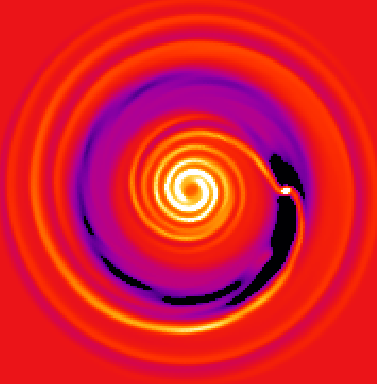 7.2 MB .AVI
7.2 MB .AVI
Gap opening, migration type II (in a gap) , 200x200 grid; final mass of the planet = 1 Jupiter mass; disk mass 0.02 M_sun
 review of planet formation
review of planet formation
 next topic: small planets
next topic: small planets
You will sometimes notice a mild shaking of the whole
picture. This is not an artifact,
but results from a small and freely evolving eccentricity
of the planet in the simulation.
The center of mass of the system is fixed at the origin
of coordinates. If the system is
eccentric then both the planet and the disk will oscillate
with the orbital period.
Typically, a planet might be started with e=0.01, and
by the end of the simulation e would
decay to one-half of that value.
The following movies are fairly similar, and both
simulate a 1 or 1.5-Jupiter mass planet
in a solar nebula somewhat more massive than the minimum-mass
solar nebula. Disks are non-selfgravitating in these calculations.
The mass of the planet is introduced over the initial
5-10 periods, to avoid transient disk
response (which PPM would love to keep around, being
a low-dissipation numerical
scheme). Our code (at the particular resolution
used, see below) has effective disk
viscosity corresponding to alpha of order few*0.001.
The simulations presented here were done on a 200x200
or 400x400
square grid, covering 4*a(0)
(4 initial semi-major axes of the planet along each direction).
The simulated time is
100-150 initial periods. For instance, if the initial
distance a(0)=5 AU, the total simulation
time would be up to ~1600 yrs, yet under this short period
of time the large simulated mass
of the nebula forced a vigorous migration from a(0)
to a third of that value.
Please click on the selected image to load the .avi simulation.
[xanim is one shareware program that can be used for
viewing the movies under Unix.
PCs should have no trouble with .avi, but if your browser
displays a static first frame,
please make sure to click on it to start the video.]
 7.2 MB .AVI
7.2 MB .AVI
Gap opening, migration type II (in a gap) , 200x200 grid; final mass
of the planet = 1 Jupiter mass; disk mass 0.02 M_sun
 12.7 MB .AVI
12.7 MB .AVI
Gap opening, migration type II (in a gap) , 200x200 grid, final mass
of the planet = 1.5 Jupiter masses; disk mass = 0.02 M_sun.
At the end of simulation the disk is artificially faded out (to illustrate
the fact that protoplanetary disks are disappearing after ~1-10 Myr)
so that only the star and the planet on a tight orbit remain.
 8.2 MB .AVI (RECOMMENDED!)
8.2 MB .AVI (RECOMMENDED!)
Gap opening, migration type II (in a gap) , 400x400 grid; planet
grows from 10 Earth to 1.5 Jupiter mass; disk mass 0.03 M_sun.
 homepage
homepage